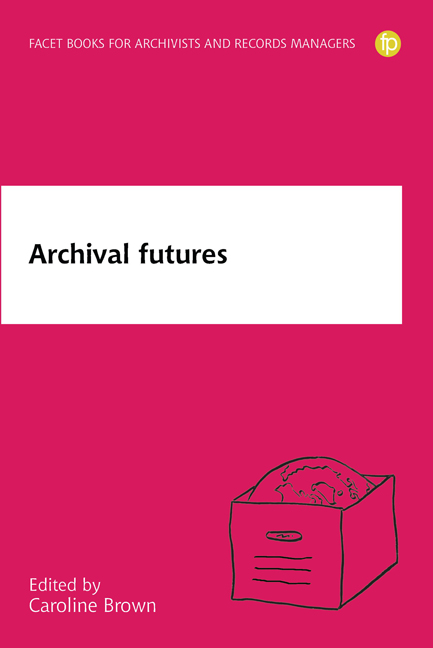Book contents
- Frontmatter
- Dedication
- Contents
- Notes on contributors
- Introduction
- 1 It's the end of the archival profession as we know it, and I feel fine
- 2 Whose truth? Records and archives as evidence in the era of post-truth and disinformation
- 3 The future of archives as networked, decentralised, autonomous and global
- 4 Can we keep everything? The future of appraisal in a world of digital profusion
- 5 Frames and the future of archival processing
- 6 Access technologies for the disruptive digital archive
- 7 Multiple rights in records: the role of recordkeeping informatics
- 8 The accidental archive
- 9 The end of archival ideas?
- Index
6 - Access technologies for the disruptive digital archive
Published online by Cambridge University Press: 01 June 2019
- Frontmatter
- Dedication
- Contents
- Notes on contributors
- Introduction
- 1 It's the end of the archival profession as we know it, and I feel fine
- 2 Whose truth? Records and archives as evidence in the era of post-truth and disinformation
- 3 The future of archives as networked, decentralised, autonomous and global
- 4 Can we keep everything? The future of appraisal in a world of digital profusion
- 5 Frames and the future of archival processing
- 6 Access technologies for the disruptive digital archive
- 7 Multiple rights in records: the role of recordkeeping informatics
- 8 The accidental archive
- 9 The end of archival ideas?
- Index
Summary
Introduction
As archivists, we are in the business of the past. Since the advent of the digitally enabled office in the 1980s, that past is digital. Although we still talk in terms of creating ‘documents’ or ‘files’, the digital records we archive today are fundamentally different to their paper equivalents. Every step, from their original creation and use to their eventual archiving and preservation, has required new thinking, process and technology. Despite this, archivists have not significantly changed our approach to providing access to this material; our ‘first generation’ of digital archival catalogues still applies models originally developed for physical files.
In recent years, there has been much discussion of the challenges of accommodating the diversity, volume and richness of digital collections (see, for example, Johnson et al., 2014) and a new body of digital archival theory and practice is emerging. But whilst we grapple with these challenges we must remember that the shift to digital offers great potential too. If we can recognise that the essence of a digital record is data, which can be not only read but described, discovered and delivered with the assistance of digital technology, then the growth of digital archives opens up a wealth of new possibilities for access and use. The shift to digital is not a threat, but a real opportunity for the archival profession to re-examine our assumptions, embrace relevant technologies and re-invent what it means to provide access to digital archives.
The past is digital
Diversity
At The National Archives, our earliest digital accessions, dating from the start of the new millennium, include office documents, a virtual reality model, websites and executable computer code. This diversity has continued to grow. We already hold records in over a hundred different digital formats and we expect this to expand rapidly (The National Archives, 2017). None of these digital files are directly humanreadable but must be processed and interpreted with the assistance of computational tools. Some may be rendered and made viewable, others exist only as abstract data which we can manipulate and re-purpose, but not directly consume. Alongside this proliferation of formats, digital records often lack a cohesive structure, although formats such as datasets can offer pockets of order within the ‘digital heap’.
- Type
- Chapter
- Information
- Archival Futures , pp. 79 - 98Publisher: FacetPrint publication year: 2018
- 1
- Cited by



